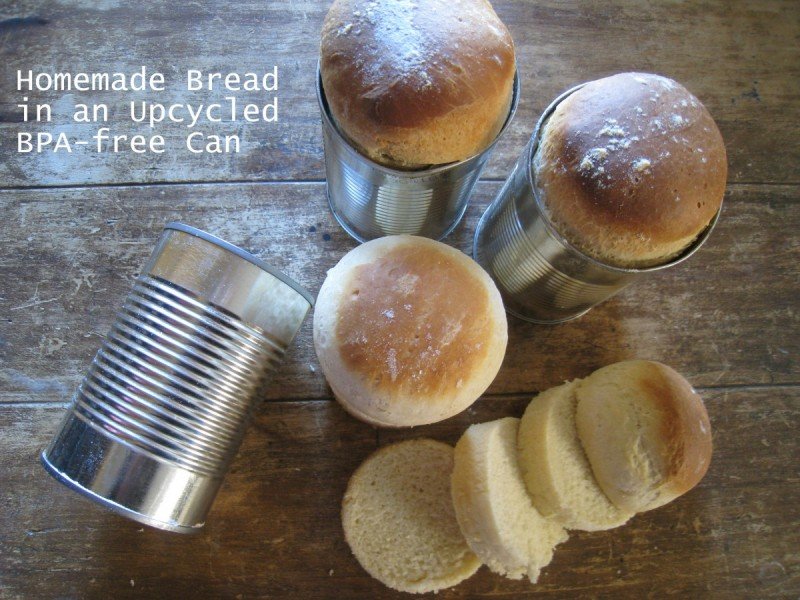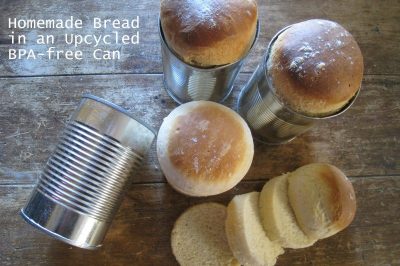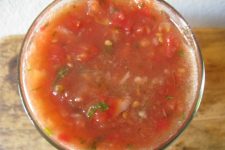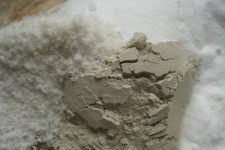
Honestly, is there anything better than the smell and taste of freshly baked homemade bread?
In this age of instant gratification, the art of bread making is at risk of being forgotten as it can be rather difficult to motivate people to make their own bread. Yet, the benefits are well-known and let’s remember…easier isn’t always better:)

What are the benefits of making homemade bread?
Whatever happened to the consumption of our daily bread? Since the mid-20th century farmers and commercial producers have manipulated the system and sought ways to mass produce while keeping the cost low. The results have been disastrous for our health (i.e. grain and gluten sensitivities), our farmlands, and our environment.
This is the case for making your own bread! The benefits are incredible. Making your own bread allows you to control the ingredients based on your dietary needs. I’ve also found that we eat less bread now that I am making it homemade — which in general is a good thing — I try to bake one day a week, usually on Mondays, and once it’s gone it’s gone.
And lastly, one of the greatest benefits of making your own bread is the revival of this nearly forgotten skill.
What ingredients should I look for?
From unbleached bread flour to 100% whole wheat to sprouted spelt the choices for ingredients are numerous (and a bit overwhelming if you ask me). I like to keep things simple in my kitchen. When deciding on ingredients, I operate under our dietary values, looking for items based on this checklist:
- Purchase directly from the farmer.
- Locally-produced and harvested (if possible).
- Non-GMO.
- Small family run operation.
- Co-ops.
- Ethical business practices.
As a family, we generally do not have any food allergies or sensitivities — for which I am extremely thankful. However, I know many people do. Therefore, when looking for ingredients you must look for those that meet your dietary requirements.
This list is in no way exhaustive. These are just a few products that I have come to love and use frequently.
Flour
Grandpa’s Grain, a farmer that grows a variety of non-GMO grains in Idaho and delivers to Arizona when he comes to see his grandchildren, is as local as it gets for me. Search LocalHarvest to find an independent grain farmer near you. King Arthur Flour and To Your Health Sprouted Flour Co. are also excellent sources for flours and grains.
Buying grain in bulk and milling it yourself is by far the most economical choice. From hand-crank manual mills to electric ones everyone has their own preference. According to my own experience, in addition to the recommendations of our facebook community, some of the most popular grain mills include: Vitamix with the Dry Blade, NutriMill Grain Mill, and the manual Family Grain Mill.
Yeast
There’s no doubt that sourdough bread is a far superior bread — and there’s nothing more frugally sustainable than harvesting the wild yeast in the air for free — but I have had many unsuccessful attempts at making it. I’ve taken the Gnowfglins Sourdough eCourse (which I highly recommend by the way), I’ve purchased cultures, and I’ve prayed over it…yet I have failed:( Talking to a dear friend — who also lives here in the desert southwest — we’ve determined our difficulties in sourdough bread-making are due to the arid climate (Just a guess…what do you think?). I will continue on my quest to create the perfect sourdough bread loaf…but until then it’s old-fashioned yeast bread for me.
Since most of the instant yeast on the grocery store shelves, unless otherwise labeled, contain GMO’s (genetically modified organisms) be sure to know your product and it’s source. Rapunzel Rize Yeast is a bit more expensive, but well-known for it’s adherence to organic and non-GMO practices.
Sweetener
I substitute local, raw honey in all my bread recipes.
The Recipe
There are several bread recipes that produce excellent results, but today I would like to share with you my favorite recipe for white yeast bread (it’s been modified from a recipe found in Forgotten Skills of Cooking.
Gather the ingredients:
-1 2/3 cup lukewarm water
-1 packet dry yeast
-5 1/2 cups unbleached bread flour
-2 teaspoons salt
-1 1/2 teaspoons honey
-2 tablespoons butter, lard, or olive oil
Directions:
1. Activate yeast according to packet directions. This usually means placing it in a small amount of lukewarm water, along with the honey, for a few minutes.

2. Sift together the flour and salt.
3. Cut the butter, lard, or olive oil into the flour.

4. Then pour in the yeast mixture and the remaining lukewarm water. Mixing until a loose dough is formed. Be sure to add water or flour as needed.
5. Now it’s time to knead the dough. This step can be performed for 5 minutes by using an electric Kitchen-Aid tool or a Bosch appliance. The most sustainable method is to learn how to knead by hand (performed for 10 minutes). Even if you use an electric mixer (like I do), it is super important to have the knowledge and practice kneaded by hand occasionally in order to refine your skills. Here’s a great video to help.
6. After kneading, put the dough in a large bowl and allow to rise for 1 1/2 to 2 hours, covered, and placed in a warm moist environment.

7. Once dough has doubled in size, knead it again for 2-3 minutes. Cover again and let the dough rest for 10 minutes.

8. Shape dough into loaves (this recipe makes 2 standard loaves or 1 standard loaf and 4 BPA-free bean can loaves) and place into well oiled pans. If using upcycled, BPA-free bean cans — a great way of using what you have to bake bread — grease the can and line the bottom with parchment paper.

9. Once in pans, allow dough to rise doubling in size again (approximately 20-30 minutes).

10. Preheat oven to 450 degrees fahrenheit.
11. Brush top of bread with water or egg wash.
12. Bake for 25-35 minutes. Note: When done, bread should sound hollow when tapped.

13. Slice and enjoy!
Note: If you are going to use an upcycled can, be sure that it has been clearly labeled as a BPA-free can.
Share your homemade bread-making experience!






I’m newish to healthy, whole food, so I’m loving your site and recipes! Thanks for sharing! I do have a question though. From what I’ve found in doing my research, aren’t we supposed to avoid cans for their potential of them being lined with BPA? So reusing them may not be a healthy choice? I’m just asking, there may certainly be something I’m not aware of!
Yep! You have to look out for that…but thankfully now there are companies, like Eden Foods, that have BPA-free canned goods:) Good thinkin’
Yum! I love the upcycled can idea.
I love homemade bread! It really does taste so much better than store bought bread. I’ve even been making Italian bread on occassion in addition to sandwich bread. Yum! Now that I’ve been making bread for a while I can taste all the chemicals in store bought bread.
I agree Vanessa! I can’t even bring myself to buy it any more!
I love that idea, thanks for sharing! I was wondering what you thought would be a good idea for storing your bread in. I’d love to stay away from plastics, but it seems almost impossible. Any ideas?
Sara
Great quesiton Sara! I have found some really great handmade bread bags on Etsy. Search for “bread bags” and you’ll see a ton of options. Plus it’s a great way to support independent folks:)
Love your bread recipe. thanks for all your wonderful ideas. I do have a question about your upcycle idea though. I have heard that the tin cans that we buy in stores that have canned food in them are sprayed with BPA. Is this a concern for re-using this item, especially with re-heating it? Or does the BPA wash out when you wash the can? Thanks for all of your great ideas, recipes, and all else. You have helped me more than you could ever imagine.
Hi Jill! Thank you very much for the encouragement:) Concerning the BPA issue…on the occassion that we do purchase canned goods we stick with the companies that produce BPA-free containers (all the more reason to get good use out of the can;)). There are a lot more of them these days (i.e. Eden Foods) so just be sure to read the labels.
Bread is on the brain this week! My own post is scheduled for Thursday. Love your etsy bread bag idea. That’s one area I’ve struggled with. Normally I wrap my bread so many times in aluminum foil that my tv gets better reception. That’s why I bake bread on Thursdays… Because Project Runway is on and I need a clearer picture.
Thanks for a new recipe!
That’s awesome Carolyn:) You made me laugh this morning!
Please, please, please add a note to the post to use only BPA free cans, since some people will not read the comments here. I see all sorts of crafts and recipes for reusing aluminum cans and it makes me cringe every time because it does not specify to use only BPA free cans. This is so important, especially since these ‘can breads’ are so attractive to kids!!!
Great recipe. I love to make bread because it is so much less expensive and I know exactly what went into it. Thanks!
Great idea Lisa! Done! Thank you for a great suggestion:)
I love this post! How fun to use a can to get a cute loaf of bread. I’ll have to try that!
I bake all of our bread from freshly ground flour. I buy my wheat berries in bulk from Amish bulk stores – certified chemical free grains from Wheat Montana. I have a whole bunch of bread recipes on my blog from 1 Grain to 5 Grain to 9 Grain to Wholewheat-Sunflower-Flax. They’re hear if you’re curious: http://www.simplifylivelove.com/category/baking
argh…* HERE. not hear. 😉
I am curious and thank you very much for sharing your link! You’re always welcome to share anything you’d like Michelle. Btw…I wish I had an Amish bulk store nearby…lucky lady:)
I bake all my bread but I have to wonder about baking in tin cans. They contain many chemicals that may be released while baking….
I have wanted to start making my own bread and this is a great place to start. Thank you. I also just got a Kitchen Aid mixer this week and it will be a great inagural recipe!!
I enjoyed your post with your great pictures. We are a large family (I have 13 children) and we eat BREAD daily in many forms…I make 5 loaves a day. I use a hard white wheat and grind it fresh daily. Making bread is a treasured lost art that I’m pleased to see come back “in” once again. Go one step further and learn about grinding your own grains. When the wheat berry is ground you bake the germ, bran and allllllllll the B vitamins, etc. that are in that God made kernel. This was one of the first steps we took about 20 years ago to improve our health. You’ll even taste the difference!
That’s awesome Val! I love grinding my own grains and I think there’s a huge difference in the flavor as well! I couldn’t agree with you more concerning the nutritional value of the entire wheat berry 🙂
Too bad this is a gluten bread 🙁
I make all our bread and am working toward growing my own. I already grind some wheat that we buy locally. I love your post, but am amused that you say you’ll stick to using good old fashioned yeast instead of sourdough. I posted yesterday on my blog about how recently commercial yeast was developed as opposed to sourdough which has been around for thousands of years. Now that’s old fashioned! I’m working on another post on using sourdough, which I’m new to and am fascinated by!
You had me worried there for a moment until I saw your warning about only using a BPA-free can. So there are no concerns about reheating this type of can?
🙂 None for me. I make my bread this way infrequently, only when we want to have a little fun, and I’m comfortable using the bpa-free cans. It may not be for everyone and that’s okay too:)
Good Evening,
So very glad I stumbled upon your website….it has been very educational and fun….I am a working chef and you have presented a lot of great ideas for my to use in my kitchen…I also would like to suggest that you might want to get a copy of Nancy Silverton’s book Bread from the LaBrea Bakery….she gives you a step by step recipe for creating your own sourdough starter made from organic grapes and distilled water….I tried it and my first batch exploded all over the kitchen counter….takes a lot of patience but it was worth it
A new frugal friend
Sharon
I have grown up with home made breads all of my childhood. It was just in the last few years that I started making my own. I stopped after my third child and just recently as of a few weeks ago I started making it again. One thing that I have read is that you can substitute upto half of the white flour amount with whole wheat. The whole foods store I go to suggested a hard whole wheat for bread making. Enjoy. Mmmm smells so good.
Now for my ignorance!…Since we rarely buy canned food, what is a BPA-free can? I gather it’s not the regular can I buy mushrooms in…can you elaborate please? Thank you!
The Farmer’s Wife
Val Colvin
Love this idea, in fact I think my one pin interest board frugal/sustainable living is practically all your posts pinned, LOL!! I think I am going to do this for dr and specialists, we see 10 regularly. I have often wanted to make something as a “thank you” to them for some time and I am thinking added some homemade jam…guess I will be looking for some jam recipes on ur blog now, since u haven’t steered me wrong yet…:-) Ty for sharing your wisdom!
Just wanted to pass along a thought on sourdough starter. I have made my own in the past, but didn’t have a lot of luck with keeping it alive. A few years ago I purchased starter from the King Arthur Baking Company while visiting their store and it was fantastic! I used and easily kept it alive for well over two years, but it got forgotten in the back of the fridge last summer during a chaotic time, and it died. I have read a lot online about different starters and making your won, but there definitely seems to be a difference in each starter and I have come to the conclusion that knowing how great that KAF starter was, it is worth my choking down the cost of the starter plus shipping to be guaranteed that fabulous bread my children have been begging for. So, all of this to say in short, if you haven’t come up with a good starter of your own, purchase the KAF sourdough starter. I am going in on it with a few family members since it so quickly multiplies and we can easily share it and the cost. It will be well worth it to get that scrumptious bread back into our diet!
I am really enjoying your blog! Was wondering what size cans you used and how many you used? I am going to going to post on our towns e-newsletter to get some of the BPA free cans. By the look of the picture the loaves may be a great size to school lunches.
Question….I live in Africa and we do not have packets of yeast….it comes in a tin and you measure out what you need. What is the equivalent to a “packet?” Excited to try this recipe! Thanks.
BPA free coffee cans are also great to bake English Muffin Bread in. I do this all all the time. Great site.
I’ve eaten at a café where they bake their bread similar to this but in terra cotta pots, could I use and adapt the same recipe?
I love baking bread but can’t seem to bake it when the cold weather comes around. I don’t havecentral heating so my house is always very cold and my dough won’t rise I try buting it in the oven with the light on but that’s not enough heat what can I do?
My husband likes to keep our house freezing in the summer or, even if warmer, I want to get the most out of rising. I boil about an inch of water in a very small pot. I swirl the boiled water in the pot and immediately place the pot in my OFF oven with the dough. This creates steam, which, intern, creates a moist warm environment perfect for rising. Sometimes, I reboil and replace to ensure the oven is still warm through the rising process. Good luck!
Thanks for the suggestion I’ll try it for sure!
Try putting your covered bowl in your bathroom and turn the hot water on in the shower for several minutes and if you have a small heater let it run with the door closed to hold the heat and moisture. Hope this helps.
So, I like the whole bread in a can idea. I have never heard of bread flour. Is it a specific flour or can you use all purpose flour or self rising? See I read your whole post. I didnt even have to ask you about the cans lol.
Beans are canned in many different quantity sizes. What size bean cans do you use? It sounds as though you are using 14.5 ounce cans if you get 1 standard and 4 bean can loaves. l was considering using coffee cans, since I cook dry beans and make my own baked beans. Years ago, I often made Boston Brown Bread (quick-bread) which was baked in 2-cup bean cans.
I noticed you did not say what type of non-GMO wheat you were using. Hard Red, Hard White or Soft White. I do grind my own flour and have been looking for recipes. There are many bread recipes but none that specifically say what type of non-GMO wheat they are using. I have been adapting recipes on my own. I feed the misses to the birds, I have some very well fed birds. It would be nice to find at least a few basic recipes so I don’t have to continuously tweak and feed the birds.
Looks adorable in the little round loaves. I often make banana bread in cans (BPA free) and put them in my crockpot for cooking in the summer – which I love because it’s slow and I can work in the garden while they are baking away. I’m betting your bread recipe would work well that way also. Just make sure the crockpot lid covers without any leaks. Or make a dome with foil.
Another idea in stead of using cans, you can use wide mouth canning jars (pints). They would work just as well (greased well, of course) instead of having to worry about what the cans are coated with.
Just wanted to pass this along as a thought – since canning jars are usually heat resistant.
Thanks!
I like the idea of using a can to bake bread. But how do it when you don’t have an oven in a camp or shft scenario?
Use small or large tuna cans. Slice and make hamburger buns.
I have loved baking bread for as long as I can remember. One of my earliest memories was making bread with my dad and watching it cook through the oven window. I can’t wait to pass on the tradition with children of my own some day, as there really is no comparison with store bought not to mention the smell and the time spent together in the kitchen! 🙂